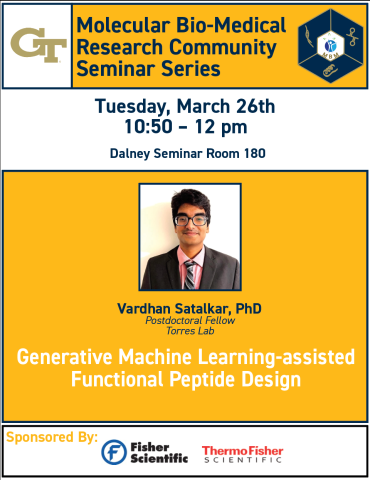event
The School of Biological Sciences Spring 2023 MBM Seminar Series presents Dr. Vardhan Satalkar
Primary tabs
Abstract: Machine Learning (ML)-driven protein design is a new frontier with broad application potential in the biological field. In particular, Generative Adversarial Networks (GANs) have emerged as a powerful ML model for protein design. A GAN comprises two neural networks, a generator and a discriminator, working in an adversarial fashion. Through an iterative training process, the generator learns to produce realistic protein structures, while the discriminator becomes adept at distinguishing between natural and generated proteins. This adversarial interplay drives the network to improve its ability to create high-quality protein designs. GANs enable researchers to explore vast sequence space, creating new proteins with desired properties such as enhanced activity and specificity. In a living organism, most proteins undergo reversible phosphorylation, a common post-translation modification, to gain regulatory functions in cellular signaling. Particularly, phosphorylation alters the physicochemical properties of the proteins, resulting in a change in the protein conformation. Although phosphorylation is widely studied, there is no generative ML model to study phosphorylation-dependent conformational changes. To overcome this technological gap, we have created a phosphoGAN model to design peptides that undergo phosphorylation-dependent conformational changes from intrinsic disorder to ordered peptide structures. To generate a training dataset for the model, we utilized in-silico techniques such as Molecular Dynamics (MD) owing to its ability to sample peptide conformational space. Notably, the MD simulations were performed using control and phosphorylated sequences. The extent of phosphorylation-mediated disorder-to-order transitions was determined using the energy profiles of the control and phosphorylated peptides. After training, the phsophoGAN model yielded 84% classification accuracy in determining phosphorylation-dependent peptides. Our phosphoGAN model also learned the physicochemical properties of the peptides responsible for the conformational changes. In the future, we plan to incorporate new deep-fake phosphopeptides as a building block of protein bio-switches to better understand phosphorylation-mediated proteinapathies such as Alzheimer’s and cancer.
Status
- Workflow Status:Published
- Created By:rbailey74
- Created:03/21/2024
- Modified By:rbailey74
- Modified:03/21/2024
Categories
Keywords
Target Audience

